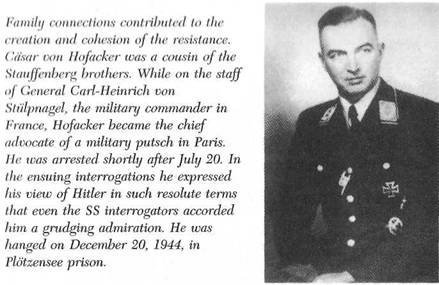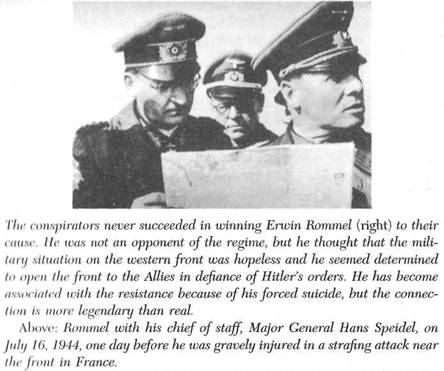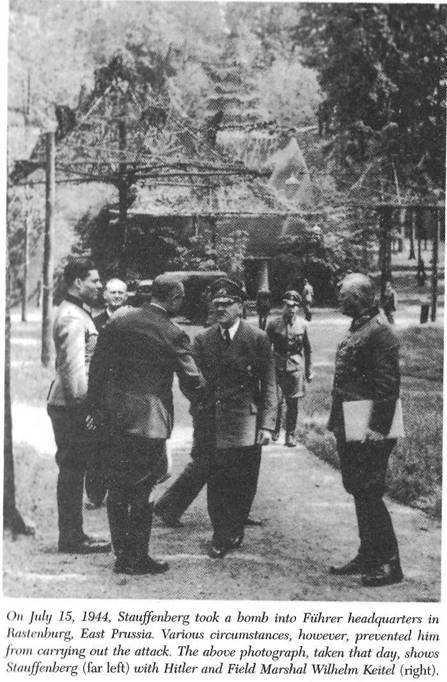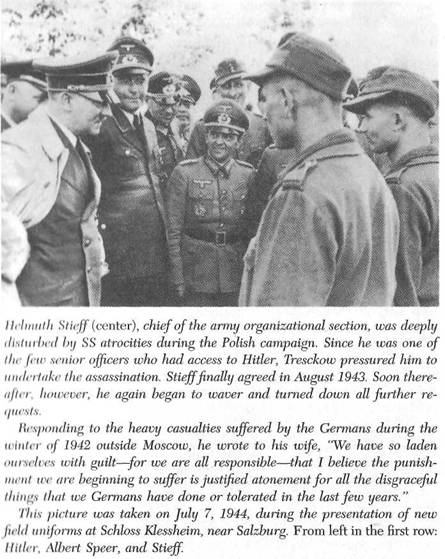never managed to produce a text acceptable to everyone. One proclamation came from Goerdeler, who evidently drafted it in concert with Tresckow and the lawyer Josef Wirmer. Leber and Reichwein produced another, and Beck a third, which was specifically addressed to the troops. Stauffenberg also drafted a proclamation, which was discussed and amended on a number of occasions within his circle of friends. The original text did not survive the war, but his close friend Rudolf Fahrner wrote a short summary from memory in August 1945.
According to Fahrner, Stauffenberg’s statement began by informing the German people “without further explanation that…Adolf Hitler was dead. Then came a few sentences condemning the party leaders,” whose behavior had created “the need and duty to intervene.” The head of the transitional government (whose name Fahrner never learned) provided “assurances that he and those who had placed themselves at his disposal wanted nothing for themselves. The nation would be summoned as soon as possible to freely determine the future constitution of the state, which would be new and innovative. The head of the transitional government,” Fahrner wrote, “swore on behalf of himself and his colleagues to act in strict and complete accordance with the law and neither to do nor to tolerate anything that contravened divine or human justice. In return he demanded unconditional obedience for the duration of his government. It was then proclaimed that crimes and unlawful acts committed under party rule would have to be thoroughly atoned for, but no one would be persecuted for his political convictions. This was followed by an announcement that the transitional government would do everything in its power to reach a truce with the enemy as soon as possible” and that this could not be achieved “without great loss and sacrifice.”11

On the evening of his return from the July 11 meeting at Berchtesgaden, Stauffenberg had met with his cousin Casar von Hofacker, who was on Stulpnagel’s staff in Paris, to orchestrate plans for the coup. Hofacker informed him that Field Marshals Hans von Kluge, who had recently been named commander in chief in the West, and Erwin Rommel, the chief of Army Group B, had both said that Allied superiority, especially in the air, was so great that the front could be held for only two or three more weeks at best. The troops were “withering” under the incessant onslaught. Stulpnagel was most willing to assume an active part in the coup, while Kluge remained as coy as ever and Rommel basically kept his distance. Rommel had endured a tense confrontation with Hitler one month earlier at the Wolf Gorge II headquarters near Margival, north of Soissons, incurring Hitler’s wrath by calling attention to the Allies’ vast material advantage and advising that the war be ended. But Rommel was not prepared to resort to violence. A few days later he drafted an “ultimatum” telegram to the Fuhrer, in which he begged him to draw “the political consequences” of the imminent collapse of the western front; but he was still unwilling to go any further. It remains an open question whether Rommel would ever have joined the opposition. The growing chasm between him and the conspirators in Berlin is apparent in the fact that he allowed his chief of general staff, Hans Speidel, to persuade him to remove the word
When Stauffenberg flew to Rastenburg in the early morning of July 15, along with Fromm and Captain Friedrich Karl Klausing, the coup was more thoroughly planned and the circle of supporters wider than four days earlier. Stauffenberg and Olbricht’s determination to take the plunge that day is clearly evident in Olbricht’s decision to issue the Valkyrie alert to the guard battalion and the army schools around Berlin at around eleven o’clock, or two hours before the earliest possible assassination attempt. In so doing, he risked squandering the only opportunity he would have to act on his own authority. Moreover, Stauffenberg had apparently abandoned his insistence that the attack be carried out only if Himmler was present.

Immediately on arriving at Rastenburg, however, Stauffenberg encountered Fellgiebel and Stieff, both of whom were adamant that the attack be canceled because of Himmler’s absence. They also told Stauffenberg that Quartermaster General Eduard Wagner had been most definite the previous evening that the assassination ought only to be carried out “if the Reichsfuhrer-SS is present.” Both Olbricht’s decision to issue the Valkyrie alert and Stauffenberg’s evident exasperation with his own hesitation on July 11 seem to indicate, though, that this time Stauffenberg was determined to overcome any such objections.
But “it all came to nothing again today,” Stauffenberg was forced to admit to Klausing after the briefing as they headed for dinner in Keitel’s special train. According to one version of events, Stieff prevented the attack by removing the briefcase with the bomb while Stauffenberg was out of the conference room making a telephone call to army headquarters in Berlin. According to another version, Stauffenberg himself wavered, worrying that Stieff, Wagner, and Fellgiebel’s vehement insistence that the attack not be carried out amounted to an abrogation of their agreement to participate. All that Stauffenberg ever said on the subject was that, to his surprise, “a meeting was called at which he himself had to give a report, and thus he never had an opportunity to carry out the assassination,” his brother Berthold recalled.13
The real reasons the attack of July 15 was called off can no longer be determined with any certainty. Whatever they were, though, this failure highlighted the resistance’s most serious deficiency. There is no doubting the moral integrity of the conspirators, their hatred of the Nazi regime, and their horror at the atrocities committed in Germany’s name. But the distance between outrage and action is great. In his telephone call to Berlin, where Witzleben, Hoepner, Olbricht, Mertz von Quirnheim, Hansen, Haeften, and many others were gathered, Stauffenberg, faced with the opposition of Stieff, Wagner, and Fellgiebel to an attack that would not also kill Himmler, apparently intended to ensure that his fellow conspirators were still with him and to win a consensus for proceeding despite Himmler’s absence. Alter a half hour of dithering, which wasted precious time and demonstrated to the impatient Stauffenberg how much his fellow conspirators relished endless discussion and debate, the answer came back that the majority of those assembled wanted to postpone the attempt. None of them, apart from Mertz von Quirnheim, seems to have appreciated the traumatic effect their response had on Stauffenberg. That evening Mertz spoke to his wife about the “deeply depressing feeling… of finding yourself all alone at a moment when great courage and determination are required to succeed.” Of the abortive efforts to bring the bomb to Hitler one conspirator noted that for the third time in just a few days “Stauffenberg has gone down that terrible road in vain.”14

According to one account, the news that the attack had been postponed once again eased the tension at army headquarters on Bendlerstrasse and gave rise “to an almost euphoric mood.” This report may not be reliable, however, particularly with regard to General Olbricht. He knew only too well what consequences might attend his unauthorized issuance of the Valkyrie orders in Fromm’s absence.15 Olbricht departed at once to cancel the untimely alert. He drove to the affected units in Potsdam and Glienicke, and, concealing his in volvement, expressed his “particular appreciation” to General Otto Hitzfeld, the commander of the Doberitz infantry school, who was partially initiated into the conspiracy. He also made note of the fact that the new commander of the Krampnitz panzer school, Colonel Wolfgang Glaesemer, probably could not be won over to the cause, and rescinded the alert.
The next evening Stauffenberg met for the last time with his closest friends. Gathered together at the house on Tristanstrasse in the Wannsee district of Berlin where he lived with his brother Berthold were Ulrich Schwerin von Schwanenfeld, Peter Yorck von Wartenburg, Fritz-Dietlof von der Schulenburg, Adam von Trott zu Solz, Casar von Hofacker, Albrecht Mertz von Quirnheim, and Georg Hansen. Once again they discussed ways of proceeding: the “western solution,” outlined above, and the “Berlin solution,” according to which the central signals system would be seized for twenty-four hours and Hitler’s headquarters outmaneuvered by a number of irreversible withdrawals of German forces. Both these ideas were rejected, as was the idea discussed occasionally of ending the war by means of a direct agreement between the commanders in chief of the various national armies, speaking as “one soldier to another” and circumventing governments entirely.

All these solutions ran aground on the hard fact that no progress could be made in any of these directions- either with the Allies or with the German commanders-so long as Hitler was alive. The Allies had absolutely no intention of negotiating with him and the commanders little stomach for openly opposing him. The only option left, the conspirators on Tristanstrasse concluded, was indeed assassination. There is some indication that Stauffenberg was eager to hold this lengthy discussion, which stretched well into the night, in order to allay once and for all both his own qualms about doing “the dirty deed” and those of so many others. It was now clearly too late for the conspirators to turn the assassination of Hitler to advantage and negotiate better political terms with the Allies. All that remained was the possibility of reducing the number of war victims and sparing Germany some

